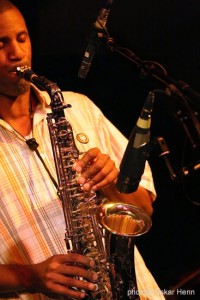Blues and
Jazz go very much hand in hand. Starting with Blues is the way to get your feet wet in the difficult but rewarding art of improvising. Our approach is three-pronged:
- First familiarize yourself with Basic Blues Chord Progressions by John Lull.
- Then absorb the bluesy feeling by listening to the legendary Rock/Blues saxophonist Sonny Del-Rio.
- Then follow the Blues Rules below.
Rules Of The Blues
[There are several versions of these floating around in the net.]
1. Most Blues begin, "Woke up this morning..."
2. "I got a good woman" is a bad way to begin the Blues, unless you stick something nasty in the next line like, "I got a good woman, with the meanest face in town."
3. The Blues is simple. After you get the first line right, repeat it. Then find something that rhymes... sort of: "Got a good woman with the meanest face in town. Yes, I got a good woman with the meanest face in town. Got teeth like Margaret Thatcher, and she weigh 500 pound."
4. The Blues is not about choice. You stuck in a ditch, you stuck in a ditch--ain't no way out.
5. Blues cars: Chevys, Fords, Cadillacs and broken-down trucks. Blues don't travel in Volvos, BMWs, or Sport Utility Vehicles. Most Blues transportation is a Greyhound bus or a southbound train. Jet aircraft and company motor pools ain't even in the running. Walkin' plays a major part in the blues lifestyle. So does fixin' to die.
6. Teenagers can't sing the Blues. They ain't fixin' to die yet. Adults sing the Blues. In Blues, "adulthood" means being old enough to get the electric chair if you shoot a man in Memphis.
7. Blues can take place in New York City but not in Hawaii or any place in Canada. Hard times in Minneapolis or Seattle is probably just clinical depression. Chicago, St. Louis, and Kansas City are still the best places to have the Blues. You cannot have the blues in any place that don't get rain.
8. A man with male pattern baldness ain't the blues. A woman with male pattern baldness is. Breaking your leg cause you were skiing is not the blues. Breaking your leg 'cause a alligator be chompin' on it is.
9. You can't have no Blues in a office or a shopping mall. The lighting is wrong. Go outside to the parking lot or sit by the dumpster.
10. Good places for the Blues:
a. Highway
b. Jailhouse
c. An empty bed
d. Bottom of a whiskey glass
11. Bad places for the Blues:
a. Nordstrom's
b. Gallery openings
c. Ivy league institutions
d. Golf courses
12. No one will believe it's the Blues if you wear a suit, 'less you happen to be a old ethnic person, and you slept in it.
13. You have the right to sing the Blues if:
a. You older than dirt
b. You blind
c. You shot a man in Memphis
d. You can't be satisfied
14. You don't have the right to sing the Blues if:
a. You have all your teeth
b. You were once blind but now can see
c. The man in Memphis lived
d. You have a pension fund
15. Blues is not a matter of color. It's a matter of bad luck. Tiger Woods cannot sing the blues. Sonny Liston could. Ugly white people also got a leg up on the blues.
16. If you ask for water and your darlin' give you gasoline, it's the Blues
17. Other acceptable Blues beverages are:
a. Cheap wine
b. Whiskey or bourbon
c. Muddy water
d. Nasty black coffee
18. The following are NOT Blues beverages:
a. Perrier
b. Chardonnay
c. Snapple
d. Slim Fast
19. If death occurs in a cheap motel or a shotgun shack, it's a Blues death. Stabbed in the back by a jealous lover is another Blues way to die. So is the electric chair, substance abuse and dying lonely on a broke-down cot. You can't have a Blues death if you die during a tennis match or while getting liposuction.
20. Some Blues names for women:
a. Sadie
b. Big Mama
c. Bessie
d. Fat River Dumpling
21. Some Blues names for men:
a. Joe
b. Willie
c. Little Willie
d. Big Willie
22. Persons with names like Michelle, Amber, Debbie, and Heather can't sing the Blues no matter how many men they shoot in Memphis.
23. Make your own Blues name Starter Kit: a. name of physical infirmity (Blind, Cripple, Lame, etc.) b. first name (see above) plus name of fruit (Lemon, Lime, Melon, Kiwi, etc.) c. last name of President (Jefferson, Johnson, Fillmore, etc.) For example: Blind Lime Jefferson, Jackleg Lemon Johnson or Cripple Kiwi Fillmore, etc. (Well, maybe not "Kiwi.")
24. I don't care how tragic your life: if you own even one computer, you cannot sing the blues.
 ” as a practical example so, that we can learn a simple and workable method to accomplish the same feat in our own solos.
” as a practical example so, that we can learn a simple and workable method to accomplish the same feat in our own solos. Andrew Campbell lives in Sydney Australia, where he plays and teaches. He has been a regular SOTW Forum contributor, under the alias of "Dog Pants", since 2001. Andrew hopes that this lesson will encourage other players to explore both Eddie Vinson and the many other great Blues Sax players.
Andrew Campbell lives in Sydney Australia, where he plays and teaches. He has been a regular SOTW Forum contributor, under the alias of "Dog Pants", since 2001. Andrew hopes that this lesson will encourage other players to explore both Eddie Vinson and the many other great Blues Sax players. 

























 If
If  If Hewlett-Packard made toasters... They would market the
If Hewlett-Packard made toasters... They would market the 








![Reblog this post [with Zemanta]](http://img.zemanta.com/reblog_b.png?x-id=093ed23b-47fc-4ae4-8e72-a460ad40f856)







